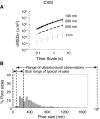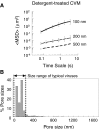Nanoparticles reveal that human cervicovaginal mucus is riddled with pores larger than viruses
- PMID: 20018745
- PMCID: PMC2818964
- DOI: 10.1073/pnas.0911748107
Nanoparticles reveal that human cervicovaginal mucus is riddled with pores larger than viruses
Erratum in
- Proc Natl Acad Sci U S A. 2011 Aug 23;108(34):14371
Abstract
The mechanisms by which mucus helps prevent viruses from infecting mucosal surfaces are not well understood. We engineered non-mucoadhesive nanoparticles of various sizes and used them as probes to determine the spacing between mucin fibers (pore sizes) in fresh undiluted human cervicovaginal mucus (CVM) obtained from volunteers with healthy vaginal microflora. We found that most pores in CVM have diameters significantly larger than human viruses (average pore size 340 +/- 70 nm; range approximately 50-1800 nm). This mesh structure is substantially more open than the 15-100-nm spacing expected assuming mucus consists primarily of a random array of individual mucin fibers. Addition of a nonionic detergent to CVM caused the average pore size to decrease to 130 +/- 50 nm. This suggests hydrophobic interactions between lipid-coated "naked" protein regions on mucins normally cause mucin fibers to self-condense and/or bundle with other fibers, creating mucin "cables" at least three times thicker than individual mucin fibers. Although the native mesh structure is not tight enough to trap most viruses, we found that herpes simplex virus (approximately 180 nm) was strongly trapped in CVM, moving at least 8,000-fold slower than non-mucoadhesive 200-nm nanoparticles. This work provides an accurate measurement of the pore structure of fresh, hydrated ex vivo CVM and demonstrates that mucoadhesion, rather than steric obstruction, may be a critical protective mechanism against a major sexually transmitted virus and perhaps other viruses.
Conflict of interest statement
The authors declare no conflict of interest.
Figures



References
-
- Cone R. In: Mucosal Immunology. Mestecky J, et al., editors. San Diego: Academic; 2005. pp. 49–72.
-
- Gipson IK. Human endocervical mucins. Ernst Schering Res Found Workshop. 2005:219–244. - PubMed
-
- Chilvers MA, O’Callaghan C. Local mucociliary defence mechanisms. Paediatr Respir Rev. 2000;1:27–34. - PubMed
-
- Carlstedt I, Sheehan JK. Structure and macromolecular properties of cervical mucus glycoproteins. Symp Soc Exp Biol. 1989;43:289–316. - PubMed
Publication types
MeSH terms
Substances
Grants and funding
LinkOut - more resources
Full Text Sources
Other Literature Sources
Medical
Miscellaneous

